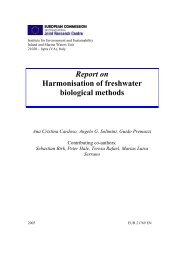Lakes and Watercourses
Lakes and Watercourses
Lakes and Watercourses
Create successful ePaper yourself
Turn your PDF publications into a flip-book with our unique Google optimized e-Paper software.
Environmental Quality<br />
Criteria for <strong>Lakes</strong> <strong>and</strong><br />
<strong>Watercourses</strong><br />
Choice of parameters<br />
Environmental Quality Criteria for <strong>Lakes</strong> <strong>and</strong> <strong>Watercourses</strong> should be<br />
used to evaluate the results of environmental monitoring <strong>and</strong> other<br />
studies. The parameters <strong>and</strong> methods to be used for this purpose are<br />
largely determined using the Swedish EPA Environmental Monitoring<br />
H<strong>and</strong>book. Similarly, studies commenced before publication of the<br />
h<strong>and</strong>book are governed by the Agency’s General Guidelines for<br />
Coordinated Monitoring of Receiving Bodies.<br />
The Swedish EPA method instructions contain a large number of<br />
parameters. It is hardly feasible or even desirable to produce model<br />
criteria for all of them. Instead, the parameters selected for this report are<br />
those considered to be the most important indicators of water quality in a<br />
wide sense. Hence, chemical parameters include those indicating threats<br />
to the environment such as eutrophication, acidification <strong>and</strong> the<br />
presence of metals. Among biological parameters are measures of the<br />
state of different parts of food chains <strong>and</strong> which in some cases are<br />
relevant to use of the water. The biological parameters do not usually<br />
reflect specific threats; rather they provide an integrated measure of the<br />
environmental situation as a whole <strong>and</strong> any impact to which an aquatic<br />
area may be exposed. The environmental relevance of each parameter is<br />
explained in detail in the individual chapters <strong>and</strong> in the reasons given for<br />
each type of investigation in the EPA Environmental Monitoring H<strong>and</strong>book.<br />
For various reasons it has not been possible to include some parameters,<br />
which do in fact represent important aspects of water quality.<br />
These include measures of hydrological <strong>and</strong> substrate conditions. Nor<br />
has it been possible to formulate instructions for assessing changes in<br />
water quality over time.<br />
An outline of the parameters included is given in Table 1 on pages 14<br />
<strong>and</strong> 15.<br />
Classification <strong>and</strong> class delimitation<br />
Environmental Quality Criteria use two types of scale: one for assessing<br />
current conditions <strong>and</strong> one for assessing deviation from reference values.<br />
13















![Accommodation booking form [PDF]](https://img.yumpu.com/39471785/1/184x260/accommodation-booking-form-pdf.jpg?quality=85)

